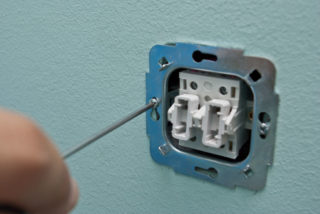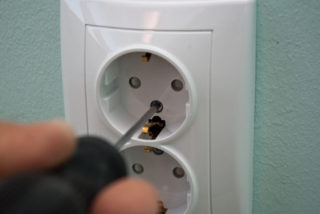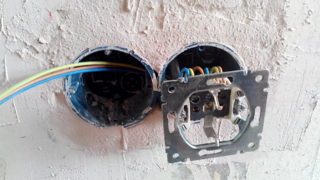When installing electrical outlets and switches, it should be borne in mind that their installation takes many problems, therefore, it is necessary to install only high-quality and long-term products that can serve a very long time. It's nonsense that you will give a little more when buying such items, but then there will be much less problems with them.
With use, the costs will pay off several times, especially if instead of the fashionable plastic inner part of the socket, you use a standard ceramic one. Ceramics conduct less electricity and are more resistant to mechanical stress.
Circuit breaker placement
Installing a light switch on the corridor does not take much trouble. If the hallway is long and wide, just install two switches on each side. If necessary, you can illuminate both one side and two at once.
Location of outlets
And even if you have a printer or copier, you can easily connect it to a computer outlet.
When placing electrical outlets in the kitchen, you must immediately determine the number and location of kitchen appliances. Since the refrigerator and stove are used almost constantly, it is necessary to provide them with a constant supply of electricity. So already two outlets will be occupied. For the rest of the smaller household appliances (boiler, coffee maker, toaster), you can use one or a double outlet, which is quite enough to provide these devices with electric current.
Socket in the bathroom
Some people have made it a habit to install sockets in the bathroom. Such an event will be unsafe, since the relative humidity in the bath is higher than in ordinary rooms.
There is a risk of short circuits and wiring blockages. An unpleasant sight. Therefore, it is better to use electric energy for a washing machine or hair dryer from the corridor.Operation problems should not arise, since a small extension cord is able to develop the required length of wire to transmit electricity. But the outlet itself ceases to be a source of danger.
Installation recommendations
And then you will have to do some minor repairs to correct this misunderstanding. Wires to outlets and switches should be run vertically, as is common in most homes. In this case, you will know exactly the location of dangerous wires and will not make a hole in them with a puncher. Otherwise, the whole house will turn into a small fireworks display, which can end very badly not only for the building itself, but also for its owner. To pass the wires in the wall, it is necessary to knock out small grooves in it up to three millimeters thick. And after the operation, seal the grooves with plaster and reliably putty. By the way, if for some reason the wiring must pass near the floor, it is necessary to raise it a certain distance, so that later, when installing the plinth, an electric storm does not happen.











